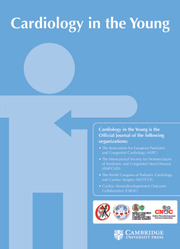Crossref Citations
This article has been cited by the following publications. This list is generated based on data provided by
Crossref.
Li, Jing-Jing
Liu, Yuan
Xie, Si-Yuan
Zhao, Guo-Dong
Dai, Ting
Chen, Hong
Mu, Lan-Fang
Qi, Hai-Ying
and
Li, Jia
2019.
Newborn screening for congenital heart disease using echocardiography and follow-up at high altitude in China.
International Journal of Cardiology,
Vol. 274,
Issue. ,
p.
106.
Kudaiberdiev, Taalaibek
Akhmedova, Irina
Imanov, Bakytbek
Abibillaev, Damirbek
Kadyraliev, Zhunus
Shoonaeva, Nurgul
Satarova, Chinara
Imanalieva, Gulzada
Tilemanbetova, Kayirnisa
Zhakypova, Zarema
and
Tursunbekova, Gulnaz
2019.
The results of a three-year research program on assessment of primary diagnostic issue of congenital heart defects in children under 1 year and the availability of cardiac surgical care in the Kyrgyz Republic.
Heart, Vessels and Transplantation,
Vol. 3,
Issue. Issue 2,
p.
74.
González-Andrade, Fabricio
2020.
High Altitude as a Cause of Congenital Heart Defects: A Medical Hypothesis Rediscovered in Ecuador.
High Altitude Medicine & Biology,
Vol. 21,
Issue. 2,
p.
126.
Kalisch-Smith, Jacinta Isabelle
Ved, Nikita
and
Sparrow, Duncan Burnaby
2020.
Environmental Risk Factors for Congenital Heart Disease.
Cold Spring Harbor Perspectives in Biology,
Vol. 12,
Issue. 3,
p.
a037234.
Sydykov, Akylbek
Mamazhakypov, Argen
Maripov, Abdirashit
Kosanovic, Djuro
Weissmann, Norbert
Ghofrani, Hossein Ardeschir
Sarybaev, Akpay Sh.
and
Schermuly, Ralph Theo
2021.
Pulmonary Hypertension in Acute and Chronic High Altitude Maladaptation Disorders.
International Journal of Environmental Research and Public Health,
Vol. 18,
Issue. 4,
p.
1692.
Tekgündüz, Kadir Şerafettin
Bilen, Merve
Kara, Mustafa
Laloğlu, Fuat
and
Ceviz, Naci
2021.
Oxygen saturation and perfusion index screening in neonates at high altitudes: can PDA be predicted?.
European Journal of Pediatrics,
Vol. 180,
Issue. 1,
p.
31.
Qi, Shenggui
Wang, Chunyan
Li, Li
Li, Tengyan
Chen, Qiuhong
and
Wang, Jing
2021.
Association Between miR-143/145 rs4705343 Polymorphism and Risk of Congenital Heart Disease in a Chinese Tibetan Population.
Genetic Testing and Molecular Biomarkers,
Vol. 25,
Issue. 12,
p.
735.
Li, Jingjing
Wang, Xiaorong
Liu, Yuan
Zhao, Guodong
Dai, Ting
Chen, Hong
Liao, Haiyan
Qi, Haiying
and
Li, Jia
2021.
Prevalence and Spectrum of Complex Congenital Heart Disease in the Neonatal Intensive Care Unit at High Altitude in China.
Congenital Heart Disease,
Vol. 16,
Issue. 1,
p.
45.
He, Shangfei
Zhao, Fengqing
Liu, Xudong
Liu, Fangzhou
Xue, Yumei
Liao, Hongtao
Zhan, Xianzhang
Lin, Weidong
Zheng, Murui
Jiang, Junrong
Li, Huoxing
Ma, Xiaofeng
Wu, Shulin
and
Deng, Hai
2022.
Prevalence of congenital heart disease among school children in Qinghai Province.
BMC Pediatrics,
Vol. 22,
Issue. 1,
Klein, Jennifer
Dwyer, Gina
Donofrio, Mary T.
and
Krishnan, Anita
2022.
Geographic Distribution of Congenital Heart Disease: A Single Surgical Center Experience.
The Journal of Pediatrics,
Vol. 240,
Issue. ,
p.
117.
Chang, Shuting
Zhang, Guanzhao
Sun, Nengjun
Yuan, Xinpeng
Wang, Qingting
Zhu, Lin
Zhang, Feiyue
Xiu, Yu
Dong, Yang
Chen, Yonghong
Zhao, Zhanpeng
Liu, Xiao
Shao, Qiang
Xu, Xiaofeng
Wang, Anshun
Li, Mengjiao
and
Li, Bo
2022.
Prevalence of Congenital Heart Disease at Extremely High Altitudes in Tibet and the Establishment of a New Free Treatment Model.
Congenital Heart Disease,
Vol. 17,
Issue. 6,
p.
709.
Wang, Wujiao
Xiang, Yongguo
Zhu, Lu
Zheng, Shijie
Ji, Yan
Lv, Bingjing
Xiong, Liang
Li, Zhouyu
Yi, Shenglan
Huang, Hongyun
Zhang, Li
Liu, Fangli
Zhang, Tong
Wan, Wenjuan
and
Hu, Ke
2022.
Myopia progression and associated factors of refractive status in children and adolescents in Tibet and Chongqing during the COVID-19 pandemic.
Frontiers in Public Health,
Vol. 10,
Issue. ,
Sempertegui Moscoso, Rodrigo
Palacios-Berrazueta, María Gabriela
Ponce-Jara, Francis
Vásconez-Montalvo, Andrea
Aguinaga-Romero, Fernando
Villegas-Álvarez, Carolina
Hoyos, Ángela B
Vásquez-Hoyos, Pablo
Fajardo, Carlos
and
Burbano Ortiz, Carlos
2023.
Asociación entre altitud y ductus arterioso persistente en recién nacidos prematuros de la red de unidades EpicLatino en el periodo 2015 – 2020..
Pediatría,
Vol. 56,
Issue. 4,
p.
e445.
Zhang, Shuqin
Zhang, Bin
Wu, Jianying
Luo, Jin
Shi, Haomin
Qi, Jirong
and
Yang, Huilian
2023.
The Prevalence of Congenital Heart Disease among School-Age Children in China: A Meta-Analysis and Systematic Review.
Congenital Heart Disease,
Vol. 18,
Issue. 2,
p.
127.
Juárez García, Valeria
Fernanda Camarillo González, Thalía
Rut Rodríguez Cornejo, Eunice
and
José Curi-Curi, Pedro
2024.
Reperfusion Injuries - Advances in Understanding, Prevention, and Treatment.
Vol. 4,
Issue. ,
Lin, Tian
Jia, Huaping
Li, Yunming
Xu, Yongxing
Zhao, Bei
Zheng, Dong
Yan, Hongfeng
Zhao, Meihui
Li, Yanlei
Xia, Liping
Zhou, Fengxia
Liu, Cuiping
Ma, Ke
Mi, Ma
and
Gu, Jianwen
2024.
Epidemiological Survey of Congenital Heart Disease Among Children Aged from 2 to 18 in Suo County, Nagqu, Tibet.
High Altitude Medicine & Biology,
Vol. 25,
Issue. 2,
p.
129.





